CHAPTER III
Action at Vossenack
As previously mentioned, the town of VOSSENACK lay astride a road which ran along the top of an open ridge. The town was about a city block wide and two thousand yards in length. Near the center of VOSSENACK the church formed a prominent landmark and overlooked the deep draws from the surrounding woods which reached up to the outskirts of the town on the north, east, and south.
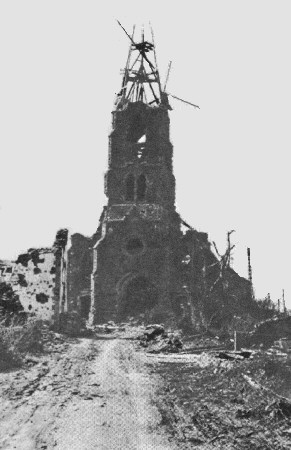 |
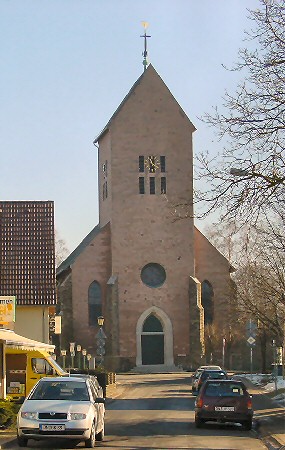 |
| The ruined of church of Vossenack.
|
The Saint Josef Church was rebuilt after the war.
|
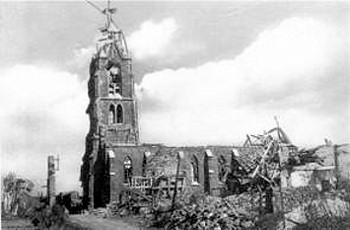 |
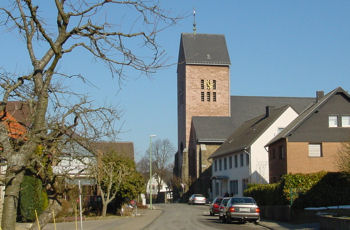 |
| Church of Vossenack. (1945) |
Church at Vossenack. (2003) |
At 020900 November, after an hour's artillery preparation, the 2nd battalion, 112th Regiment, jumped off from the vicinity of GERMETER in the attack on VOSSENACK. Moving down the ridge Company G was on the left, Company F on the right, with Company E following in reserve. In support of this attack was Company C, 707th Tank Battalion. The 1st platoon under Second Lieutenant William S. Quarrie, plus two tanks from the second platoon, attacked with Company G. The three remaining tanks of the second platoon with First Lieutenant James J. Leming in command, attacked with Company F. Second Lieutenant Joseph Novak's 3rd platoon with Company E was to assist in mopping up the objective or to come to the aid of the other tank platoons if required. The attack progressed satisfactorily and the infantry was on the objective shortly after 1000.
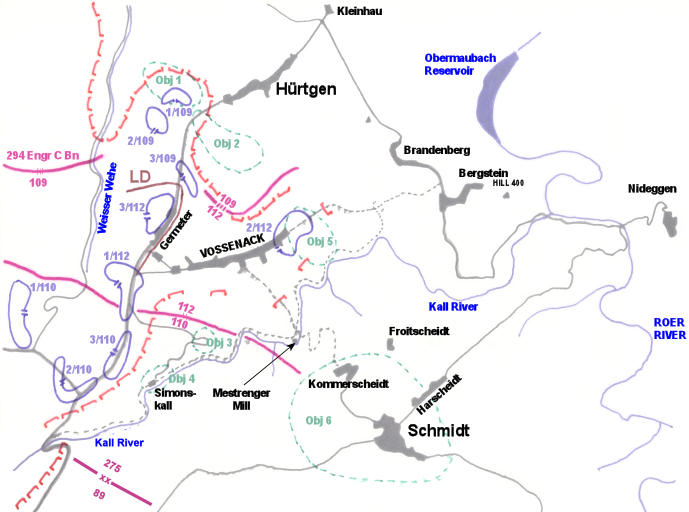
2 November
The tanks, however, had trouble from the start. The first-platoon sergeant's tank had a track blown off while moving through a gap in an American laid protective minefield. Next Lt. Quarrie's tank became mired in the soft ground. Captain George S. West, commanding the tank company, saw the difficulty, came forward, and placed the Lieutenant in his tank, and the platoon moved on. The last tank of the second platoon went too far south and was knocked out by bazooka fire. The platoon commander, Lt Leming, who was having trouble with his tank gun, radioed the third platoon for assistance. One section came forward and was sent toward the east end of the town. After getting his gun in action, Leming moved forward only to have his tank immobilized by a German mine.
Meanwhile, Capt. West left his own tank to Lt. Quarrie and commandeered a third platoon tank which struck a mine in VOSSENACK shortly afterward and was put out of action. He then mounted a battalion headquarters tank which was in the town performing forward observation for the battalion assault gun platoon. The difficulties of command under the conditions which faced Capt. West can be appreciated. His platoons were in support of three different infantry companies; he could only act as an expediter and to do this he required both transportation and communication.
A tank retriever which came into the town to evacuate Lt. Leming's tank was hit and immobilized by German artillery. Thus by 1300 five tanks and one retriever were out of action which reduced the effective strength of the company by roughly one-third. Most of these tanks were recoverable, but they were of no immediate value to the infantry which they were supporting. At 1600 the company returned to an area within 400 yards of GERMETER and spent the night in that location, remaining on call from the infantry.
About 0500 the next day, the tank company moved forward, occupied supporting positions on the north and east edges of VOSSENACK, and remained in these positions encountering no enemy activity until heavy artillery began to land about 1200. All tanks except three were ordered back into GERMETER. The three remaining were those of the 1st and 2nd platoon leaders and the battalion headquarters tank ordered to stay in the town for communication purposes. The command tank of the first platoon was still immobilized but could be used in this capacity. About 1230 hostile artillery fire hit the battalion headquarters tank, knocking it out, and at 1530 the only operative tank in VOSSENACK was ordered back.
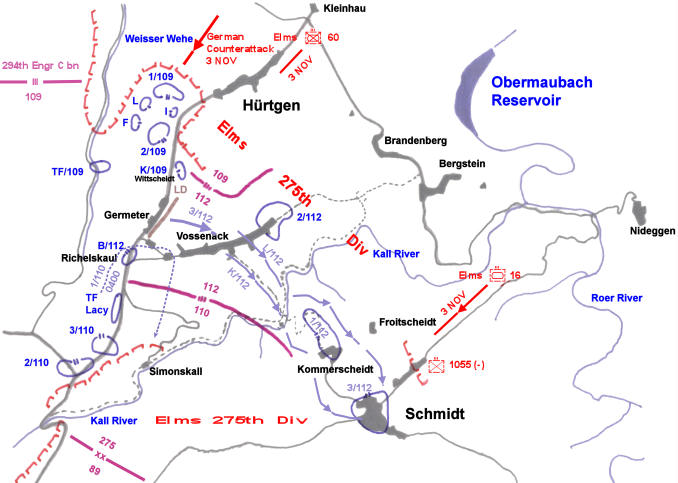
3 November
No further tank action occurred until the following morning when the 2nd platoon was used in fire support role for one of the battalions of the 110th Regiment to the south. The mission was completed by 0705 and the platoon returned to company control. At 1030, on the request of the infantry commander in VOSSENACK, the four tanks of the first platoon went forward to neutralize small arms and machine gun fire coming from the woods north of town. The tanks moved in and fired HE at ranges of 150-200 yards, neutralized the enemy fire, and returned to GERMETER at 1100. Again at the request of the infantry, one section of the 2nd tank platoon plus the company commander in his tank went back into VOSSENACK, where the 2nd battalion, 112th Regiment, was still holding at considerable cost. The eastern end of the town and the eastern slope of the ridge where the infantry had dug-in was subjected to continuous battering artillery which took its toll of casualties and undermined the morale of the defenders. The western end of the town was relatively quiet except for troops passing through en route to KOMMERSCHEIDT. Medical and other vehicles continued to use the route through VOSSENACK to the south. (See Map 2, Appendix V.)

4 November
While the three tanks were engaged in counteracting small arms fire at the direction of the infantry, Capt. West's tank broke a drive shaft. He ordered the other tanks back and stayed with his own until he was towed back by company maintenance about midnight.
At 1815 Lt. Quarrie with three tanks of the first platoon moved to the position occupied by Company F. He spotted tracer fire coming from a draw east of the town and radioed the position to the battalion assault guns, which fired into this draw until the divisional artillery took over the mission. A PW later stated that this fire broke up a counterattack which was forming in the draw, indicating the advantage of having an assault gun platoon organic to the tank battalion. Lt. Quarrie remained with Company F all night while the balance of the tanks were in GERMETER.
Capt. West, moved at 0700, 5 November, with Lt. Leming's three tanks, to positions from which they could fire into the woods north of V0SSENACK on mortar and enemy small arms locations. Here one tank received a direct HE hit which killed the driver and destroyed the 75-mm gun. The other tanks returned to GERMETER about 1000. At l400 Lt. Leming went forward with his platoon in order to repel a reported counterattack. Capt. West, accompanied this platoon which moved up to support Company G. Lt. Quarrie's platoon continued to support Company F. The entire eastern end of the ridge came under intense heavy artillery fire, and by 1500 both platoons were receiving heavy fire and withdrew to GERMETER apparently without orders. Capt. West, in his tank, remained in turret defilade behind Company G. At 1730 Lt. Quarrie again reported to Company F with an extra tank borrowed from the 2nd platoon. He remained with them all night, returning to GERMETER early the next morning.
After Lt. Quarrie reported back, Lt. Col. Ripple received orders to get all available armor into VOSSENACK to stop an enemy counterattack; Companies B and C, 707th Tank Battalion, were committed. Company B initially sent its 1st platoon, under First Lieutenant Carl A. Anderson, into town. This platoon was soon followed by Capt. George S. Granger, the company commander, and the 3rd platoon commanded by Second Lieutenant Danforth Sherman. Company C, with its eight tanks, came last. The situation was described by the tankers as one of complete confusion. Many of the infantry were running to the rear out of the town. None of the tankers knew where the front lines were, or where the counterattacking enemy was located. The first platoon of Company C occupied a position northeast of VOSSENACK and fired to the north until about 0900 when it pulled back to GERMETER. Meanwhile, in Company B, Lt. Anderson evacuated the crew of a damaged Company C tank by placing one man from the crew in each of his tanks and returning with his entire platoon to the LD. Although he asked for and received permission from Capt. Granger to make this evaluation, there seems to be no sound reason for taking all of these tanks out of action at a time when presumably they were badly needed. He soon returned to VOSSENACK, however, and relieved the 2nd platoon, Company C, by O930. When the Company B tankers first entered VOSSENACK they knew nothing about the ground and less about the situation. As a result they fired first into buildings occupied by the friendly infantry and caused some casualties. They also fired perilously close to the third platoon of Company C and some tank destroyers which were in the town. During all of this time Capt. Granger was trying to locate the infantry battalion commander to get an intelligent picture of what was happening.
Whether or not there was a German counterattack is uncertain from the available accounts. Lt. Novak's Company C, 3rd platoon is credited with stopping some German infantry approaching the town from the east and southeast. The one fact that can definitely be reconstructed is that the American infantry defenders, having been subjected to unceasing artillery and mortar fire for five days, had reached the limit of their endurance. When the first shouts of counterattack went up, panic spread like wildfire and the men left their holes and ran to the rear. When Capt. Granger located the infantry battalion CP he found that the battalion commander, though present, was a combat fatigue casualty and that a captain on his staff was in actual command.
In the initial action of Company B in VOSSENACK it is of interest to note that requests and orders to Company B came from Capt. West of Company C rather than from the tank or infantry battalion commander. Capt. West was in town at the time Company B was committed, but the accounts indicate that even he did not know the infantry situation. Capt. West was killed about 0900 by an enemy shell which landed in the turret of his tank. Capt. Granger took command of the tanks of both companies and kept his 1st and 3rd platoons in the vicinity of VOSSENACK the remainder of the day. Artillery fire knocked out three tanks and the only direct action against the enemy was the destruction of a small infantry counterattack. At 0900, Lt. Quarrie of Company C, came forward and relieved the tanks of Company B for the night.
This day's action at VOSSENACK is a graphic illustration of the dangers attending such vague orders as those sending tanks into the town. The communication and coordination necessary between the tanks and infantry had completely broken down. When Capt. West was killed the remaining tanks were under the command of Capt. Granger who was not familiar with the terrain and who was also occupied in trying to establish contact with the local infantry defenders.
By this time the foot troops in VOSSENACK consisted largely of engineers of the 1171th Engineer Combat Group (two battalions) supporting the 28th Division. During the night, Brig. Gen. George. A. Davis, assistant division commander, visited the town and ordered the engineers to retake the eastern end which had been abandoned by the infantry and reoccupied by Germans in undetermined strength.
About 0300 on the following day, Lt. Quarrie's tank was disabled by a direct hit on the turret, while another tank of his platoon was hit in the engine compartment. Lt. Quarrie was not injured, however, and at 0500 he was called to the engineer CP for his recommendations as to the employment of tanks in the engineer counterattack to take place that morning. He explained that he was to be relieved by Lt. Johnson of Company B, but recommended that tanks not be used on the left (north) flank of the town because of its vulnerability from the high ground at HÜRTGEN and BRANDENBERG. (See Appendix I.) At 0730 Lt. Johnson, accompanied by Lt. Anderson and Capt. Granger arrived. Lt. Anderson led Quarrie's platoon back to GERMETER, and Quarrie followed with Capt. Granger after orienting Johnson on the engineer plan.
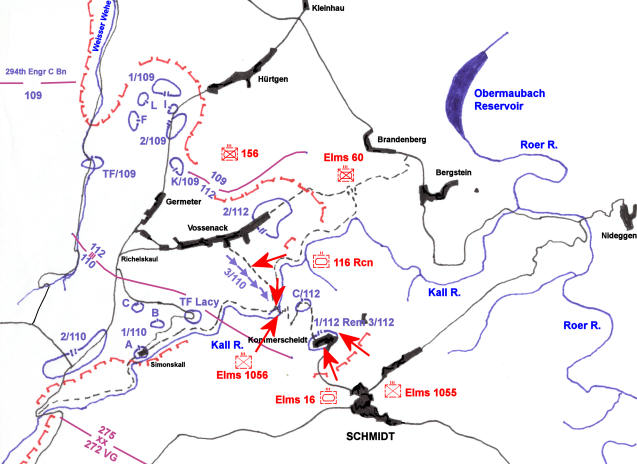
6 November
At this time the engineers held a north-south line through VOSSENACK at about the center of the town. Lt. Johnson's platoon was to move up the right (south) flank of the town immediately after the artillery barrage which heralded the engineer attack. One company of engineers was to attack from house to house up the main road of the town with Lt. Johnson's tank firing two rounds into each house before the assault. This plan succeeded and the engineers were able to retake the entire town.
Despite direct and indirect artillery and bombing and strafing from friendly planes, casualties to the tanks were largely from other causes. One was immobilized by a mine, another became bogged in a shell hole, while a third became inoperative because of a broken gas line.
An incident occurred here which emphasizes the necessity for dependable communications. A garbled radio message caused the engineers to withdraw from the eastern end of the town under the impression that they were ordered to hold north-south line through the church. They did this without notifying the tanks and then called down artillery and mortar fire on the eastern end of the town. This fire fell around Lt. Johnson and his tanks until he succeeded in getting it moved farther east. The vacant part of the town was again occupied by friendly troops and the tank platoon remained in position until relieved by Lt. Anderson and his platoon at 1800. This platoon immediately received direct artillery fire from its right front and Lt. Anderson ordered his tanks to move back, intending only that they back out of the line of fire. At this point his radio failed and because of the loss of contact, the rest of his platoon returned all the way to GERMETER. He started back after his platoon, but en route he met Lt. Col. Henbest, commanding the 2nd battalion, 109th Regiment, which had been ordered to relieve the Engineers of the defense of VOSSENACK. The colonel told him that he and Capt. Granger had decided to keep the tanks in GERMETER since they could move up easily when desired, and their presence only drew unwelcome artillery fire.

7 November
About 0500, on the morning of 8 November, Lt. Col. Henbest called for tanks, and at 0600 Lt. Anderson, with four tanks, moved into VOSSENACK and occupied positions at the western end of the town. His platoon moved in and around the town for the rest of the day except between 1200 and 1400 when he returned for re-supply. He was relieved at 1200 by Lt. Novak of Company C, who remained in the town after Anderson's platoon returned. Anderson's main action during the day consisted of firing his tanks and adjusting artillery fire on moving targets and gun flashes. He also called and received an air strike on some enemy tanks which had been sighted. After dark both platoons returned to GERMETER; Lt Novak came back on foot ahead of his platoon suffering from severe shoulder and leg wounds.
8 November marked the last of the action for Company C in VOSSENACK. During the fighting here it had tried to keep one platoon in town with the infantry at all times. This effort was not usually in response to definite requests for armor for specific missions, but was rather an attempt to give continuous armored support.
At 0630 on'9 November, the 2nd platoon of Company B, numbering three tanks, moved into VOSSENACK. By now it was snowing and visibility was nil. At 0900 one of the sergeant tank commanders asked permission of Lt Johnson to return to GERMETER. His gunner was almost hysterical from battle exhaustion and needed a rest. Permission was granted, and two tanks were left in the town. Later in the morning an officer (unidentified) from the artillery, walked over and asked the tanks to leave town. They did so, apparently without questioning the authority of the order. This concluded active participation of Company B, 707th, in VOSSENACK, although it remained on alert status in GERMETER during 9 and 10 November.
The action of the 707th Tank Battalion at VOSSENACK is a perfect example of the unnecessary loss of lives and material occasioned by:
- lack of mutual understanding between the armor and infantry arms;
- lack of efficient communication between these two arms or a failure to use such means;
- lack of exchange of tactical information between the arms on the lower levels.
It was vital to the 28th Infantry Division to hold VOSSENACK since the division MSR to SCHMIDT passed through this town. If the tanks had been used as a mobile reserve and given complete, clear and concise orders when committed, the losses both to the armor and the infantry would have been less.
The role of the engineers in this action should not be overlooked. Their mine reconnaissance and mine clearing activities did little to prevent the loss of tanks from mine damage. At a minimum, routes of counterattack should have been cleared early in the action in order for the infantry to receive maximum benefit from the armor in the mobile reserve capacity.

